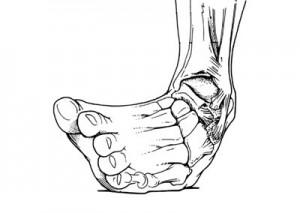Athletic Injuries 101: Inversion Ankle Sprains
 In this edition of Athletic Injuries 101, Dr. Sarah Ytmsa explains lateral ankle sprains, including the causes, treatment, and symptoms of inversion ankle sprains.
In this edition of Athletic Injuries 101, Dr. Sarah Ytmsa explains lateral ankle sprains, including the causes, treatment, and symptoms of inversion ankle sprains.
Definition: An inversion ankle sprain, involves injury to the ligaments on the lateral part of the ankle, typically between the fibula and the talus and/or calcaneous. Your ankle turns in during injury and often results in a popping sound and immediate swelling around the joint.
Grades of Lateral Ankle Sprains
Grade 1: These usually account for 85% of inversion injuries and involves only the anterior talofibular ligament. You would present with a slight limp, minor swelling and pain around the lateral malleolus, and a fairly stable joint. 2-10 days of rehabilitation is often sufficient for return to full ability..
Grade 2: This usually involves a sprain into two or more of the surrounding ligaments on the outside of the ankle. There is immediate swelling, potential bruising, and pain surrounding the ankle and even the foot. You will experience a definite limp, the foot turned in naturally, and you wouldn’t be able to hop, run, weight bear 100%, etc. Anywhere from 10-30 days is often sufficient for return to full ability.
Grade 3: This is often worse than breaking the ankle itself. There is a complete tear of two or more ligaments and the joint is very unstable. Swelling, pain, bruising into the foot and up the lower leg all accompany a grade 3 sprain, along with the inability to weight bear. Anywhere from 30-90 days is the time length before returning to play.
Rehabilitation
The following can be done to rehab a sprained ankle:
- Ultrasound – this helps to disperse fluid and inflammation that accumulates with injury, as well as increase blood supply to the ligament and damaged surrounding tissue.
- Laser – this helps to increase the damaged cells ability to restore normal function, therefore, decreasing inflammation, increasing circulation, decreasing pain, and healing the damaged tissues.
- T.E.N.S or IFC – these are modalities to help with pain associated.
- Ice – ice helps to vasoconstrict or slow blood flow to an area, to help decrease swelling.
- Compression – this helps to keep swelling from accumulating in the area. This is not advised at night. Athletic tape will stabilize the joint while walking but other tape procedures such as Kinesiotape, Spidertape, Rock Tape, etc, will help to open the lymphatic system, increase blood flow, and stabilize the area.
- Exercises – balancing on one foot, range of motion (“ABC’s”) exercises, and many other rehab activities can be done and must be done to help restore proper proprioception to the area (the brain’s knowing of where the ankle joint is in space) and strength.
High Lateral Ankle Sprains
A high ankle sprain involves stretching or a sprain to, the ligaments between the tibia and fibula in the lower leg known as syndesmosis ligaments. They are above the ankle joint themselves. The mechanism of injury with a high ankle sprain is when both the lower leg and the ankle, turn outwards. Swelling is usually minor or non-existant, so these can often be difficult to diagnose.
Dr. Sarah Ytsma provides traditional chiropractic care, soft tissue manipulation/mobilation, and clinical acupuncture treatments at her office locations in Chatham (463 St. Clair Street @ Activaid – 519.358.7342) and Blenheim (110 Talbot Street @ McLauchlin Wellness – 519.676.3311 ext.1). Dr. Ytsma believes in stabilization and rehabilitation of injured joints to get you functioning and back on your feet, or in the game. For more visit http://www.drsarahytsma.ca/


